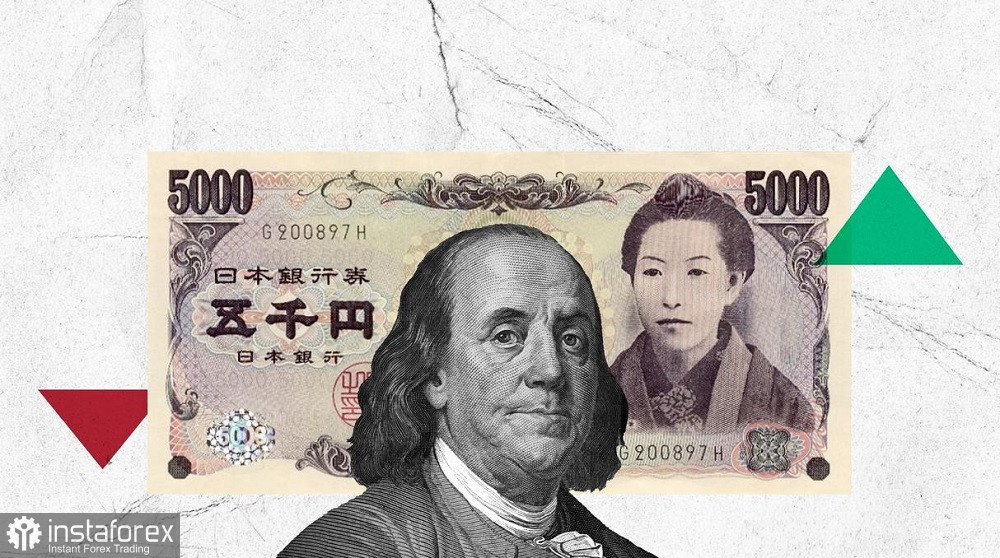The yen is stuck on a range-bound market. The Japanese currency is trading in the range of 149.70–150.90 against the US dollar for the third week in a row. Sellers are unable to gain a foothold at the levels above 149. Buyers are hesitant to enter the area above 151. On the one hand, there is uncertainty regarding the further policy moves of the Bank of Japan, on the other hand, there are the risks of currency intervention. Plus, USD/JPY traders have to adjust their strategies to the dynamic of the greenback, which, in turn, is awaiting key events of the current week, i.e. Powell's testimony in Congress and the nonfarm payrolls for February. In other words, the current fundamental background does not encourage any breakout at the moment - neither up nor down.

In my opinion, the currency pair has reached its ceiling. A downward reversal is only a matter of time. Of course, if, Jerome Powell reinforces the American currency with hawkish remarks, and the nonfarm payrolls again come out in the "green zone," the USD/JPY pair may well impulsively rise by another 100-150 pips. But such a spike will be short-lived: either the Japanese government will take action (at least verbally), or the market will pull itself together and take profits. After all, the events of past years are still fresh in memory, when, when approaching the 152 level, Japan's monetary authorities intervened on Forex. We can say that the 151.90 mark is an unconditional "red line". Once it is crossed, this will entail consequences.
Let's take a look at the weekly chart of USD/JPY. Since mid-February, the instrument has been approaching the 151 level with enviable regularity, but every time the price pulled back. The lower border of the corridor is 149.70.
However, USD/JPY buyers are hesitant to enter the market not only because of the fear of currency intervention. Traders are raising hopes the Japanese regulator will begin to normalize monetary policy in the second half of this year. Japanese inflation serves as a weighty argument for this scenario.
According to the latest data, the overall consumer price index climbed by 2.2% in February in annual terms, defying the forecast of a decline to 2.1%. The core CPI, excluding prices for fresh food, also found itself in the "green zone". Most experts expected to see it at 1.9%, but it came out at 2.0%.
In other words, inflation in Japan continues to decline, but the pace of decline has slowed.
Another important inflation indicator was published today – the Tokyo Consumer Price Index. It is considered a leading indicator for determining price dynamics throughout the country. So, certain conclusions can also be drawn based on the published figures. The overall CPI of Tokyo over the previous three months spanning from November to February consistently decreased, reaching 1.8%. But in February, it grew quite sharply to 2.6% whereas the consensus suggested a rise up to 2.2%. Tokyo's core consumer price index, excluding fresh food prices, was also in the green zone, rising to 2.5%. This component of the report showed downward dynamics for three months, but unexpectedly, inflation accelerated in February at the strongest growth rate since October 2023.
Bank of Japan Governor Kazuo Ueda has a different standpoint. He is still "full of doubts." Last Friday, he said inflation was falling "at a fairly rapid pace" and the economic recession looked like a slowdown after strong quarters. Such rhetoric once again inspired USD/JPY buyers, who once again pushed the price to 151.
Interestingly, Ueda voiced his position even before the publication of today's data. The acceleration of the CPI in Tokyo is an alarming signal that cannot be ignored by the Japanese regulator.
Another signal is rumors that the Japanese government is poised to officially declare an end to deflation (which indirectly indicates an increased likelihood of policy tightening). This information appeared in the Japanese media at the end of last week. Although Japanese Economy Minister Yoshitaka Shindo today denied these rumors, insiders still insist on the high probability of such a scenario occurring in the second half of March, after assessing the results of the annual wage negotiations (tentatively they will take place on March 13 or 15).
Thus, the keyword characterizing the situation for the USD/JPY pair is uncertainty. In my opinion, the decisive role of completing ultra-soft monetary policy will be played by the spring negotiations, that is, annual negotiations between trade unions and employers on wage increases. This means that in the near future, at least until mid-March, the USD/JPY pair will only depend on the trajectory of the US dollar index, which in turn will react to Powell's rhetoric and the February nonfarm payrolls.
The yen will come into play only when the results of the "salary negotiations" become known.
All this suggests that in the medium term, the instrument will continue to trade in the range of 149.70 to 150.90. Even if USD/JPY buyers break above 151 (if the greenback strengthens), it is advisable to ignore such attempts, since the 151 level and above area remains a potentially dangerous price territory. Therefore, it makes sense to take profits in the area of 150.90 and stay outside the market.





















